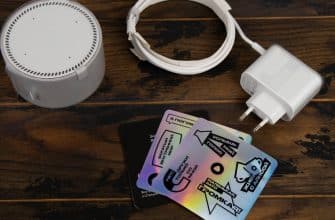The most reliable way to place home wiring is considered to be laying in strobes. This is a difficult and labor-intensive option, usually used for primary finishing or repair. Home craftsmen often use wiring masking options that do not require wall chasing.
- What is shredding and what are its disadvantages?
- What to consider when choosing wire masking?
- Options for laying wires without gating
- Floor
- Ceiling
- Walls
- Various ways to disguise
- corrugated sleeve
- flat cable
- cable channel
- disguise in furniture
- Camouflage covers
- Beads and colorful tape
- Wall installations
- Vinyl stickers
- Decorative holders
- Organizer
- Art object
- disguise behind flowers
- Masking wires from lamps
- Safety – how to hide the wires from the child?
- Helpful Hints
What is shredding and what are its disadvantages?
A strobe is a channel or a recess made in the walls specifically for laying wires. This method allows you to make the wiring completely invisible to the eye. However, shredding has several serious drawbacks. Cons of shredding:
- Damage to plaster. Masters rarely manage to create smooth channels. But even with quality work done, it is necessary to restore the finishing layer of plaster. If you ditch the walls after repair, then you have to spoil the finish – after it you need to completely change the wallpaper, and even the coating on the ceilings, as it happens that the strobes pass along the ceiling.
- A lot of dust. When knocking out channels in the walls, construction dust is intensively formed, which spreads throughout the dwelling. If gating is not carried out during the initial arrangement of the premises, then after it you have to re-do repairs – renew the walls and ceiling.
- Noise. Chasing is done with a perforator, which creates a lot of noise that annoys neighbors even if the work is done during the hours allowed by law.
- Lack of access. The wiring is hidden thoroughly, there is no free access to it. If the wires are laid in strobes, then the replacement of the wiring is possible only by laying a new wire and disconnecting the old one (from both ends).
An alternative to gating that tightly hides wiring is open cable routing methods.
What to consider when choosing wire masking?
When choosing a method of laying (masking) electrical wires, consider their technical features and length. Please note the following restrictions:
- it is unacceptable to lay cables along the walls and along the ceiling with a stretch;
- it is important that there is no heavy load on the plug near the equipment, otherwise the connector may break;
- it is forbidden to work with wires without insulation, during operation the cable may be damaged, and its insulation is broken;
- areas with chips, cuts and cracks must be insulated with electrical tape, or the damaged section of the cable should be replaced with a new one.
When choosing a cable laying option, consider the following points:
- The total length and number of wires. If we are talking about one or two wires, then under them you can make recesses or buy cable channels. If there are a lot of wires, it is easier to hide them behind drywall panels.
- The location of the wires. If the laying is organized along the ceiling, you will need a longer wire than when laying on the floor.
- Distance to sockets. If the equipment to which you want to connect the wire is near the outlets, it is recommended to disguise it.
- Safety. If there are children or pets in the dwelling, the wires must be positioned so that any contact with them, unintentional or intentional, is excluded. The cable should be placed in an inaccessible place – for example, in a wall or in a special box.
Options for laying wires without gating
Often, new equipment is connected, leaving the wires lying on the floor or hanging on the walls. It looks ugly, spoils the interior, moreover, creates a danger of equipment falling or a person who can stumble over scattered wires. If a major overhaul is being done in the house, then all the wires are laid in the walls – in strobes. If the house is wooden, the wires are usually hidden in protective corrugated sleeves. You can place the wires on one of the “faces” of the room – on the walls, on the floor or ceiling. Let’s take a closer look at these options.
Floor
It happens that the wiring needs to be thrown across the floor. This is easier to do than on the walls. If the laying is carried out after repair, naturally no one wants to groove grooves in the cement screed. We need to look for more affordable styling methods. The best option for laying wires on the floor without gating:
- In special plinths with holes. A wide range of such products is presented in construction stores. The wires are laid in the plinth, removing the removable element. After laying the “valve” is returned to its place.
- under the laminate. To implement this option, the lamellas are partially removed, under which the cable will be passed – up to the construction logs. The wire is laid in a corrugated pipe. If necessary, a space is cut in the wood for the intersections of the wires.
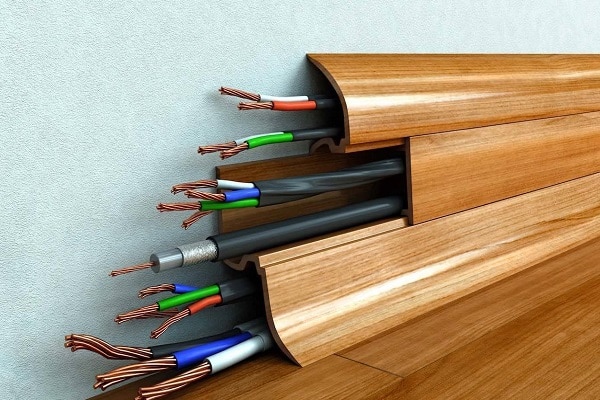
Ceiling
The choice of installation option on the ceiling depends on the type of ceiling covering. Stretch ceilings are often installed in residential premises and offices. They “eat up” the extra space, but allow you to breed upstairs as required by the power supply scheme. There are no obstacles on the ceiling for cables and they can be laid there along the shortest path, this allows:
- reduce costs;
- reduce the time of work;
- reduce the total resistance of the circuit;
- ensure a higher level of fire safety;
- if necessary, it is easy to replace the wires.
According to fire safety requirements, the cables must be closed with corrugated pipes. The same should be done with wiring laid behind stretch ceilings, in niches or plasterboard structures. It is recommended to connect all the wires into one line – this will simplify future repairs. If the ceilings are concrete, chasing is indispensable.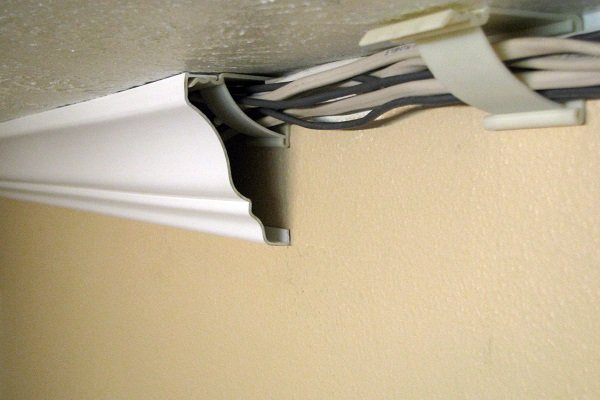
Walls
The cable on the wall can be laid in a decorative box – this option is especially good for large-diameter wires, since it will not work to hide them in the wall without repair. Other options for laying wires on the walls:
- hide in door frames;
- cover with baguettes or moldings;
- put in window slopes.
Please note that the last three options are only suitable for low-voltage wires (Internet, telephone, etc.). High voltage wires may be laid in accordance with fire safety regulations.
Various ways to disguise
There are a large number of ways to lay and mask wires, which differ from each other in laboriousness, aesthetics, safety and other features. The only thing that unites them is that they do not require gouging recesses in the walls (chasing).
corrugated sleeve
This rigid pipe not only provides protection for wires from damage of a different nature, but has a number of other advantages.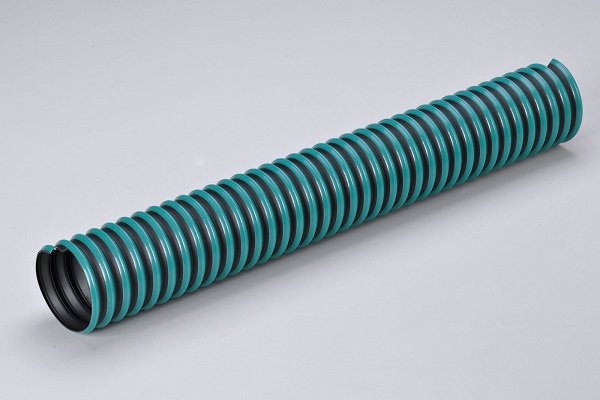 Advantages of corrugated pipes:
Advantages of corrugated pipes:
- flexibility – the product fits easily in rooms of different configurations;
- protect wires from electromagnetic influence of various emitters;
- protect the room from the induced electromagnetic field that occurs when alternating current passes through the wires.
A big disadvantage of corrugated sleeves is the low aesthetics of this product. It is more suitable for technical premises and looks extremely unnatural in living rooms. In the latter case, you have to resort to additional decoration – if the sleeve is stretched out in a conspicuous place. The corrugated pipe does not hold its shape well, therefore it will be located parallel to the floor surface, provided that it is fixed on the ceiling or on the floor. Usually, corrugated sleeves are used when it is necessary to collect all the cables in one bundle. This format is rarely used in residential premises.
flat cable
A flat cable allows you to do without gating, which is quite simply attached to the wall, and then it is covered with a thin layer of plaster.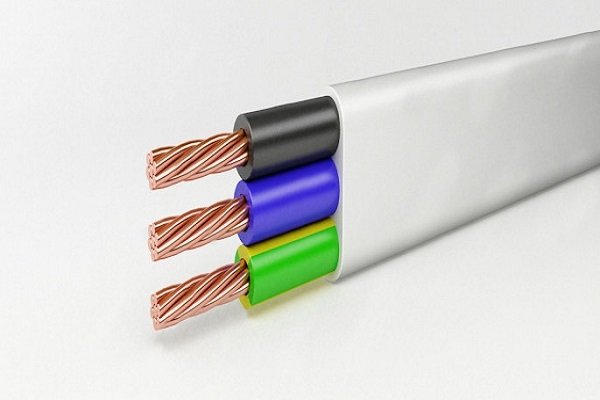 In order to avoid mistakes during the work, it is recommended to sketch a small diagram in advance – how exactly the wires will pass, where the sockets and switches will be located. Flat cable on the wall is fixed with:
In order to avoid mistakes during the work, it is recommended to sketch a small diagram in advance – how exactly the wires will pass, where the sockets and switches will be located. Flat cable on the wall is fixed with:
- metal ties;
- plastic dowels-clamps;
- quick-drying plaster;
- plastic mounting pads.
A drill is usually used to prepare a place for fittings. When the cable is fixed, plaster is applied to the wall – 10 mm thick.
cable channel
These are plastic boxes, mostly of rectangular cross section, in which electrical cords are placed. One of the easiest, most convenient, reliable and safe ways to lay cables after finishing.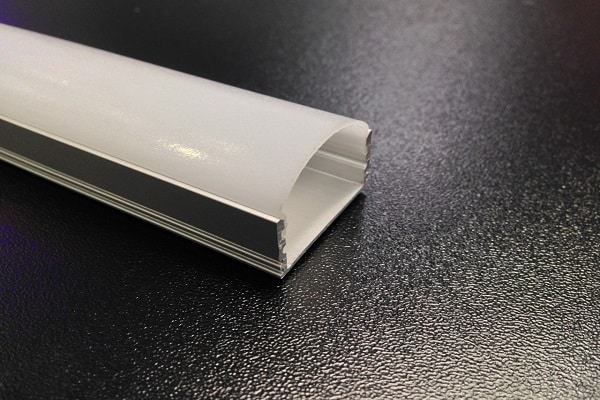 Cable channels are especially often installed in the kitchen after repairs have been made, and later this or that equipment was purchased, for example, a washing machine, air conditioning, lighting fixtures. Features of these channels:
Cable channels are especially often installed in the kitchen after repairs have been made, and later this or that equipment was purchased, for example, a washing machine, air conditioning, lighting fixtures. Features of these channels:
- you can find products of a suitable color – manufacturers produce different options;
- easily replaced and supplemented with new branches;
- made of non-combustible materials;
- reliably protect electrical wiring or other wires from mechanical damage and sunlight.
It is quite difficult to choose cable channels of a suitable color for interiors decorated in ECO, Empire, Baroque styles. But in any case, laying in a channel is better than wires dangling along the walls. For the manufacture of channel boxes, not only plastic can be used, but also metal – galvanized steel or anodized aluminum. Possible section of the box:
- U-shaped;
- Ш-shaped;
- triangular;
- semicircular.
The box to the walls or floors is made using self-tapping screws, dowels, iron brackets or anchors. In addition to the rigid versions, there are also flexible versions made of rubber or wire, as well as transparent channels.
disguise in furniture
Furniture opens up great opportunities for masking wires. Behind its vast surfaces, you can hide as many wires as you like. How to hide cables behind furniture:
How to hide cables behind furniture:
- fix on the back wall of the cabinet;
- hide behind a table leg;
- fasten under the tabletop;
- hide behind a mirror, curtain, vase, large and bushy plant.
For fixing use special holders. You can use reusable plastic clips on Velcro tape. If you are afraid to spoil the surface of the furniture, use ordinary masking tape. Wires can be masked by attaching them to the back of a countertop or cabinet.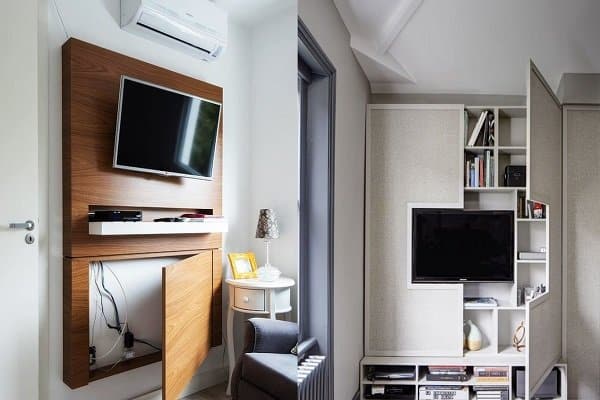 Apply one of the following methods:
Apply one of the following methods:
- For self-tapping screws. Take fasteners, the length of which does not exceed the thickness of the countertop. Usually use self-tapping screws 3.5×16 mm.
- On double sided tape. This is not the most reliable option, but it makes it easy to model and adjust the laying pattern.
If you do not want to make holes in furniture, it is recommended to use perforated screens.
Camouflage covers
You can make a cover for masking wires with your own hands. It manages to hide several cables at once. The cover is made from plastic bags, cut into long strips. A sleeve is crocheted from them, into which wires are threaded. For an extension cord with chargers, a bag of a suitable size is knitted / sewn. In some stores you can also buy plastic cases in the form of trees, pipes, sparkling snakes. In such structures, unlike cable channels, there are no protective properties, they simply cover the wires that spoil the aesthetics of the interior. To add decorativeness to the wires, you can also purchase a spiral braid – flexible and aesthetic. It can hide both one wire and a whole bunch of them.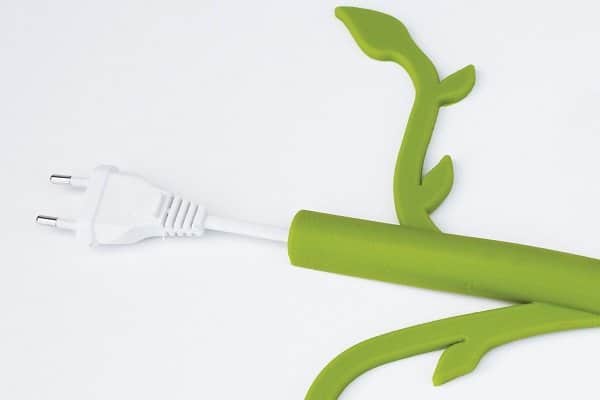
Beads and colorful tape
With the help of beads and electrical tape, the wire can be transformed into a stylish interior detail. And you don’t even have to pick it up off the floor. It is enough to decorate it with a beautiful decor.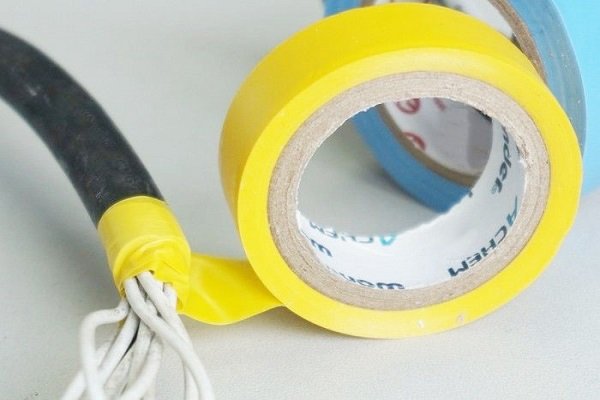 Suitable wire decor:
Suitable wire decor:
- large beads;
- colored electrical tape;
- textured twine;
- bright threads, etc.
If the wire is thin enough, you can put large beads on it. This technique is often used by designers, creating ethnic motifs. The main thing is to choose the right color of beads. It should be in harmony with the overall color scheme of the interior.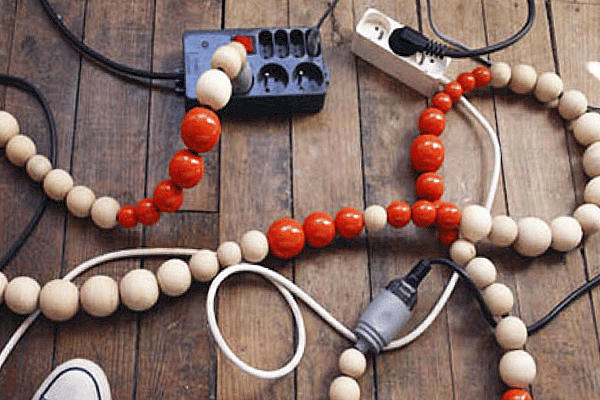 Decorating with beads will not only give the wire a presentable look, but also prevent it from fraying. Thanks to the beads, the friction of the wire with the floor will be reduced, so it will last longer.
Decorating with beads will not only give the wire a presentable look, but also prevent it from fraying. Thanks to the beads, the friction of the wire with the floor will be reduced, so it will last longer.
Wall installations
The wires can not be hidden anywhere, but on the contrary – put on display, turning them into an independent art object. To create a “panel” you need an empty wall. One must be plain, otherwise it will not be possible to achieve the desired decorative effect. Show creativity and imagination – create an unusual pattern from wires. To get a stylish installation, you need to carefully consider the outline of the picture, otherwise the wire on the wall will look tasteless and miserable. Recommended installation options:
- abstract images;
- geometric figures;
- silhouettes of houses, etc.
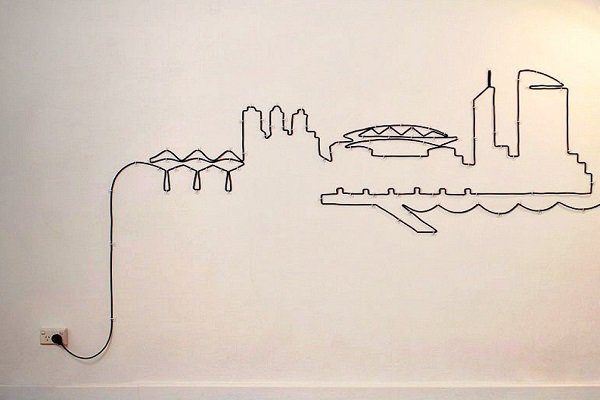 Such installations are inorganic in classic interiors, this solution is suitable for modern design – high-tech styles, loft, etc.
Such installations are inorganic in classic interiors, this solution is suitable for modern design – high-tech styles, loft, etc.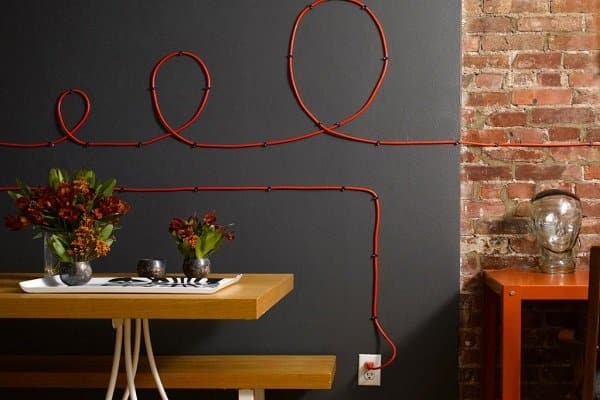 The wire is bent at a certain angle and fixed on the wall. They should be reliable, but inconspicuous. Before “drawing” a picture from wires, it is first drawn on paper – this simplifies the installation process.
The wire is bent at a certain angle and fixed on the wall. They should be reliable, but inconspicuous. Before “drawing” a picture from wires, it is first drawn on paper – this simplifies the installation process.
Vinyl stickers
Wall installations will look even more interesting if you decorate them with vinyl stickers. They can decorate even a very small piece of wire. Stickers are easy and simple to apply. To keep them well, they should be applied to even and clean surfaces. There are no traces left after the stickers. You can “draw” a tree with a wire, and vinyl stickers will be its leaves, flowers, the plinth will pass for the soil. Or you can make a separate branch out of the wire by planting vinyl birds on it. LED garlands, multi-colored ribbons, feathers, etc. will help enhance the effect.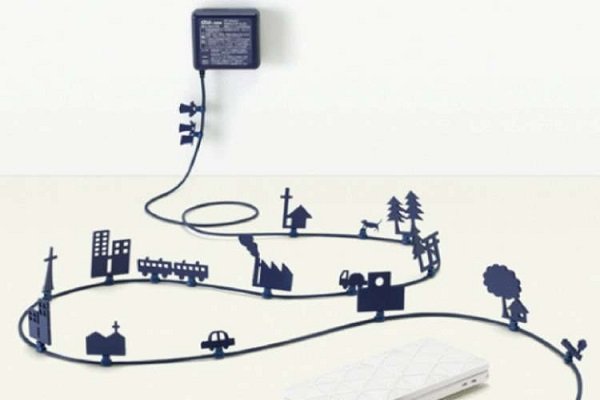
Decorative holders
It happens that there is no free wall in the room to create an installation of wires, then they can be decorated with decorative holders. They are structurally conventional clamps and securely hold the cable.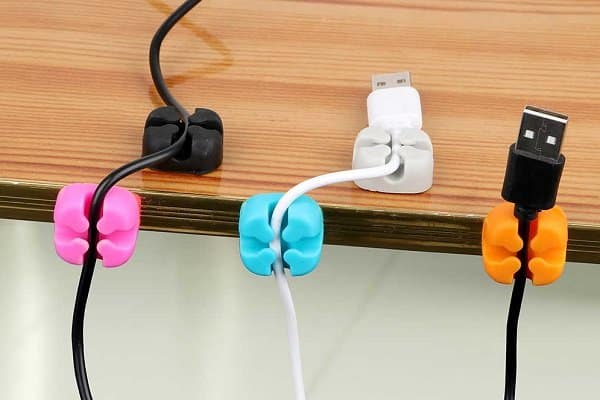 They differ from ordinary clips only in appearance – they have an interesting design and may contain various decorative elements – leaves, bird figures, etc. Fixation condition – the opening of the clips must fit the size of the cable. Holders can be replaced with decorative overlays or ties – they will present in a favorable light the most discreet cable stretched along the wall. So, a cover imitating a metal pipe will look harmonious in a loft-style living room.
They differ from ordinary clips only in appearance – they have an interesting design and may contain various decorative elements – leaves, bird figures, etc. Fixation condition – the opening of the clips must fit the size of the cable. Holders can be replaced with decorative overlays or ties – they will present in a favorable light the most discreet cable stretched along the wall. So, a cover imitating a metal pipe will look harmonious in a loft-style living room.
Organizer
If a lot of wires are concentrated at one point, they can be placed in a plastic box – an organizer. This will eliminate clutter, reduce cleaning time, and increase safety.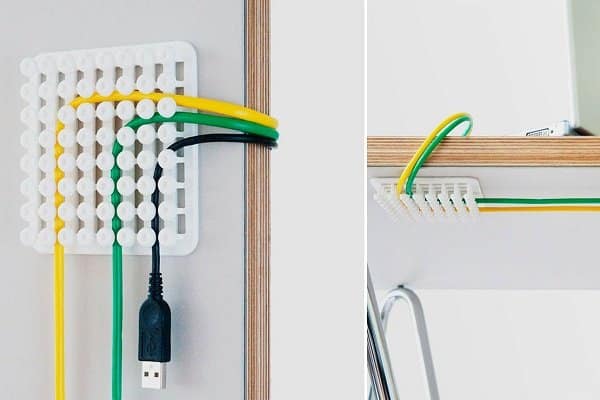 You don’t need to look for any “suitable boxes”, organizers for wires and any electrical equipment can be bought at the store. These are stylish plastic boxes with ventilation holes and silicone feet. Inside the organizer stack a variety of elements:
You don’t need to look for any “suitable boxes”, organizers for wires and any electrical equipment can be bought at the store. These are stylish plastic boxes with ventilation holes and silicone feet. Inside the organizer stack a variety of elements:
- wires;
- network filter;
- Charger;
- router.
But if you wish, you can make a similar organizer on your own. For this purpose, an old shoe box or a wooden bread box is suitable. It is enough to make holes in them and arrange them to your liking.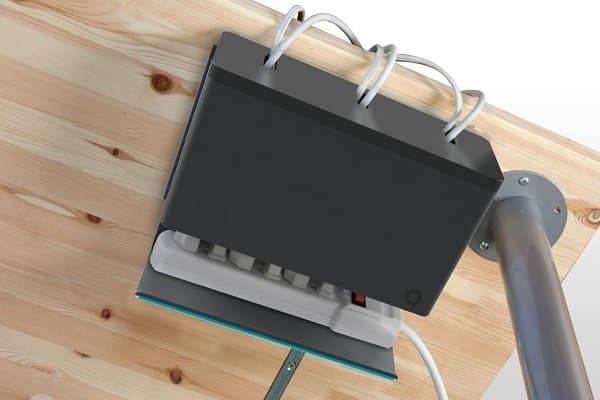 A kind of organizer can be made from a cardboard shoe box. To do this, it is enough to cut side holes in it – for passing wires. Such a product is suitable for an extension cord to which many wires are connected.
A kind of organizer can be made from a cardboard shoe box. To do this, it is enough to cut side holes in it – for passing wires. Such a product is suitable for an extension cord to which many wires are connected. Another solution is to buy a cabinet, which has a built-in niche for cables. Or you can allocate a whole box for the wires. There you can place an extension cord and gadget chargers. This will remove the confusion from the wires and put things in order in the workplace.
Another solution is to buy a cabinet, which has a built-in niche for cables. Or you can allocate a whole box for the wires. There you can place an extension cord and gadget chargers. This will remove the confusion from the wires and put things in order in the workplace.
Art object
Draw a picture on the wall with a simple pencil. And lay the cable along the drawn outlines. This will allow you to get a picture of the wires, suitable for the design of the apartment.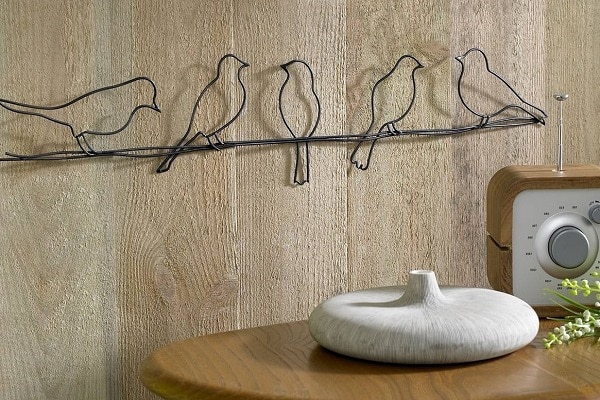
disguise behind flowers
The cable is attached to the wall with some kind of clamps. Preferably discreet, transparent. And along the wiring lines, mounted flower stands are installed. Ampel plants are planted in them – hanging and climbing. If there is no desire to deal with flowers, you can replace them with artificial counterparts.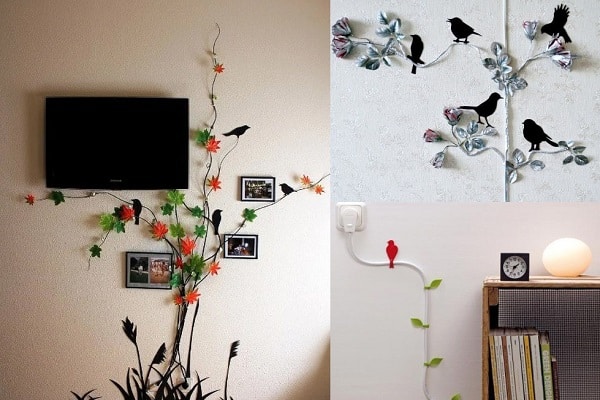
Masking wires from lamps
Currently, spot lighting in the premises is becoming popular. At the same time, long wires stretch from hanging lamps, which spoil the aesthetics of the room. The cords are hidden behind special panels that can be purchased at any construction site. Manufacturers offer products of various shapes and colors – you can choose the interior of the room.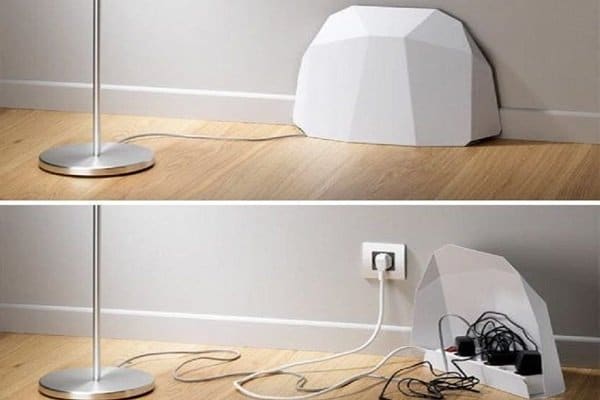
Safety – how to hide the wires from the child?
Freely accessible wires are a constant source of danger for young children. To prevent accidents, manufacturers offer a variety of protective elements – they exclude the contact of the child with conductive parts of the wiring. There are manufacturers who offer a whole series of security elements:
- fasteners that are difficult to break;
- boxes – wooden, plastic, cardboard;
- bags-cases for extension boxes.
All elements that are dangerous for children are placed in boxes that are placed in places inaccessible to them.
Helpful Hints
Laying and masking wires in an open way takes much less time and effort than installation with punched strobes. But here, too, there are a number of points that should be paid attention to when laying cables without gating. Tips from experts:
- Label all wires in advance. In order not to get confused when performing camouflage work. This will later help you quickly and correctly find the right cable.
- Wiring – low-power and power, separate from each other. Do not join in one bundle.
- Place wires from the Internet and antennas separately from all others. So that there are no extraneous interference and the signal quality does not deteriorate.
- The goal should be to keep the cable as short as possible. And a minimum of connections – this makes them safer, reduces the risk of injury.
- It happens that the braid of cables hidden in one way or another is worn out. In case of bad location. Therefore, wires located in high-risk areas should be checked as often as possible.
Video about installing a cable channel for protecting wires:
There are dozens of masking methods that allow you to beautifully and safely lay wires for various purposes, including electrical cables. When choosing a laying method, focus not only on the aesthetic result, but also on the convenience, safety and technical features of the wires.

